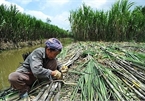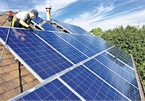which is considered to be financially attractive. The price of each kilowatt-hour generated from ground-mounted, floating, and rooftop solar initiatives are 7.09, 7.69, and 8.38 US cents, respectively. These numbers have been viral in the investment community since last year and now they are finally confirmed.
 |
|
Mai Van Trung
|
The FiT2 is profitable for most of the projects located in central and southern Vietnam but may pose a headache for those in the north. With rooftop solar, the FiT2 allows completion of legal and regulatory investment documents and opens up new extensions due to the gross metering scheme added. It allows the wholesale of electricity generated from rooftop solar systems to medium voltage lines of Electricity of Vietnam (EVN).
In addition, the decision paves the way for all of the solar farms which have been provincially approved before November 23, 2019. The eligible extension is reasonable because the developers have been struggling to pass the provincial level approval. Some have even paid for the land – if projects have a power purchase agreement (PPA) and began to construct before November 23, 2019, the total capacity to reach FiT2 is 320MW.
According to the Ministry of Industry and Trade (MoIT), there are 126 projects of a total of 8,960MW capacity listed in the master plan and 260 projects (28,300MW) in the waiting list for master plan approval. They are all eligible to enjoy the FiT2 if commercial operation date (COD) is hit before the deadline. The market will be excited and government authorities will have another busy year as there are many challenges in hydroelectricity due to extreme droughts in the central region; continuous delays and regional protests against coal-fired plants; and liquefied natural gas plants taking a long time to build and prove their competitive pricing. Along with the increased FiT for wind and biomass recently announced, Vietnam is undergoing a strong energy transition towards renewable energy following the directives and goals indicated in the Politburo’s Resolution No.55-NQ/TW on the orientation of the National Energy Development Strategy of Vietnam to 2030, with a vision to 2045. The solar farms market is fostered not only by the FiT2 but also the pilot auction projects advised by the Asian Development Bank, and the first batch of direct PPAs to utilise the master-plan-approved projects which could not catch the deadline of the first round FiT last year.
There is huge potential for international developers and investors to join mergers and acquisitions activities. For some multinational companies, this year is an important milestone for their green commitments (such as 20/30 per cent of energy used for their operations purchased from solar and/or wind power systems).
The direct PPA is the only choice to fulfill their green energy proportion instead of depending on the limit of 1 megawatt-peak (MWp) capacity of rooftop solar systems. There might be a flow of capital meant for wind farms switching to solar farms because of the wind turbine supply chain in the US and EU suffering from the ongoing health pandemic, while the solar module manufacturing industry in China is recovering with huge capacities added and time required to build solar farms varying from six to eight months. The construction of solar farms to enjoy the FiT2 can be restarted in early May if the coronavirus pandemic is controlled. Based on statistics from the MoIT, 1,600MW of solar farms have a PPA (not constructed) and 800MW (600MW in Ninh Thuan province and 200MW in Long An and Quang Tri provinces) projects are under construction and also have a PPA already. They are very likely to hit COD before the end of the year.
If half of the projects are approved in the master plan, roughly 4,000MW can be fast-tracked to COD before the deadline. It is estimated that more than 6,000MW can be realised this year thanks to local improved construction capability last year. One point to hamper the construction of solar farms is the rainy season in central and southern Vietnam between June and October.
Meanwhile, transmission line congestion problems resulting in power curtailment may not be a frequent issue because of the efforts of EVN and the private sector, which recently allowed building 500kV lines. Related to solar rooftops, installation seems not to be solely impacted by the FiT thanks to its self-consumption capability.
According to EVN, the total rooftop solar capacity installed by the end of December 2019 and in January-February this year were 377MWp, 429MWp, and 470MWp, respectively (95 per cent in central and southern Vietnam, and 5 per cent in the north). There is no available data for March yet, but if the same momentum applies, it is expected to have 20-30MWp newly added to confirm 500MWp (at least 54 per cent industrial, 12 per cent commercial, and 29 per cent residential) by the end of March. These capacities are based on the self-consumption business model (the power generated from rooftop solar systems being partially consumed by the rooftop owners, while the excess power is fed to the EVN grid for the FiT).
This business model places many burdens on developers to scale up their project pipeline. The new points from Decision 13 involve offering a gross metering scheme (rooftop solar projects can sell 100 per cent of electricity to EVN at FiT2 through their own distribution lines and transformers); specifying the rated capacity of a project’s 1MW limit (the rated capacity of inverters and/or transformers instead of rated capacity of solar modules in MWp); and legally enabling developers to sell surplus energy to EVN by issuing their invoices instead of EVN buyers, thereby allowing industrial developers who are selling electricity to factories to purchase electricity from rooftop solar systems from the factories at an agreed price. The ground-mounted and floating solar farm regulations, licences, and PPAs are all clear to go but there are many things to do with the regulatory framework for rooftop solar through the circular from MoIT and detailed guidance from EVN. For instance, the definition of solar rooftop systems in the decision should be clearly clarified.
Carefully studying the statistics released by EVN, it is surprising that the percentage of kWh fed back to the grid to enjoy the FiT varies from 50-60 per cent of total generation. These numbers do not reflect the self-consumption nature of rooftop solar schemes. Another hurdle for rooftop solar development is the reluctance of local commercial banks to finance the projects with better long-term packages with no collateral. Green finance from the international market is ready to penetrate Vietnam but it is required that international platforms are adhered to.
Therefore, we cannot expect the cost of capital for local developers to lower within this year. The 10 per cent decrease of EVN electricity rates applied for commercials and residentials to cope with the impacts of COVID-19 might prevent households, hotels, and resorts from triggering their interests in savings from rooftop solar ventures.
Hence, the main engine for rooftop solar to grow is expected to be the industrial sector.
|
GILES COOPER- Co-director, Duane Morris Vietnam LLC
Decision 13 confirms that the new FiT will only be available for projects that have their commercial operation date prior to December 31. This is a very short timeline considering the long delivery of inverters and, for many projects, procedures to complete land acquisition. While certainly welcoming, the long delay has seriously stressed many approved and licensed solar projects. Investors and developers had been left in the dark about what revenue they would receive while simultaneously being under pressure to meet construction deadlines stated in investment approvals and power purchase agreements. On the positive side, the decision confirms that projects that are eligible for the new FiT are those that obtained decisions on investment policy prior to last November 23. This throws a wider net than previous criteria that projects would have to have already started construction by that date. PHAM MINH THANH- Business development manager, Southeast AsiaWartsila Corporatio n
Many people might think that the tight COD deadline brings headaches to developers. However, it is believed that many developers have been waiting for this FiT to be officially signed for several months after the last draft so that they can reach financial closure and get their projects going again. This could be the last FiT for solar in Vietnam, which means that developers will not be able to see such attractive mechanisms again when the competitive bidding scheme will be implemented. Developers will still show a strong interest as we have seen in Cambodia. There, around 25 companies bid for a 60MW solar project backed by the Asian Development Bank. The winning bid was at 3.88 US cents per kWh which shows that renewable energy is not only clean but it will also help the country to reduce the system cost. FEDERICO BESTIANI– Director, Bestiani Engineering Company
The decision is certainly aiming to increase clarity and transparency in solar projects. In particular, regarding rooftop projects, it helps to clear gray areas in third-party investor projects, finally opening the door to real PPAs between companies. This will give more clarity to investors and a proper name to an agreement that, until last year, was called in many different forms, such as operational leasing, solar asset leasing, and energy service company contracts, including a lot of grey areas and pockets of potential issues. So this decision is an improvement. The tariff value is reasonable considering the decrease of cost of the solar equipment in comparison to the time the previous Decision 11 was issued. We expect the second FiT to create a situation similar, and even amplified, in comparison to the FiT 1, as developers now suspect that this is the last chance to get a project on FiT and, therefore, will push even harder than before. SAMRESH KUMAR- Executive chairman, SkyX Solar
It is good to finally see the release of Decision 13. While the FiT deadline and tariff for phase 2 of ground-mounted solar power remains the same, it is understandable from the government’s perspective not to extend the timeline or to offer a higher FiT, given the uncertainty around the economic impact of the pandemic. However, I expect challenges in the further development of ground-mounted solar power assets before the end of the deadline. I am especially enthused by the decision’s clarifications of regulations for rooftop solar developers to sell power directly to the roof owners. This will ensure developers do not have to find any workarounds. I hope that the government increases the threshold of 1MWp and accelerates the direct PPA for assets under 1MWp soon, because that will definitely accelerate investments in the solar power sector in Vietnam. NGUYEN THI LIEN- Vietnam project development manager, Trina Solar Co., Ltd.
The new decision is very good news for all solar investors and developers after such a long delay, showing the government’s interest in the solar market and electricity development. However, it is a bit tough at the moment as almost all countries are on lockdown. The procurement of offshore equipment is rather difficult and mobilising foreign experts to Vietnam during this time is a challenge. For the remaining 36 eligible projects for FiT2, I think the new decision will ease congestion for the current grid, and EVN’s efforts to upgrade the grid seem to work so far. Hopefully, curtailment could be reduced. Solar development should develop in accordance with regional grid capacity, not focusing on just a few provinces, to prevent grid congestion. Solar energy, especially rooftop, should be encouraged in the context of delays in some big thermal projects. BUI VIET PHUONG- Solar marketing manager, Dat Solar
Decision 13 has been widely anticipated by investors, developers, and also customers, and it will help the solar power market continue to flourish in this country, especially at the end of the year. According to the new decision, the price of rooftop solar photovoltaic has dropped by about 11 per cent, which reduces the attractiveness to investors compared to the price in its first version, Decision 11. However, the FiT is still guaranteed to attract a lot of investment that could take part in the market in Vietnam, and which could develop a multitude of energy solutions, including energy-saving projects, energy infrastructure upgrades, supply, power generation, and performance management. The new decision also prioritises rooftop solar power, as this is the market that will help to reduce pressure on transmission system investment. PHAM QUANG ANH- Energy expert
Decision 13 was issued too late and only partially addresses the needs of investors in the solar power market in Vietnam. Moreover, the expiration date for this decision should be at the end of 2021 to give the government more time to prepare the bidding mechanism. Investors should also have to prepare for a change in policy from 2021 onwards. However, the new decision includes several new features, especially allowing large-scale or rooftop solar power projects to sign contracts with parties other than EVN, and opening a competitive trading mechanism for projects that cannot apply the new FiT. Nevertheless, it is still necessary to develop clear regulations under this decision and to revise the law to have a transparent calculation method when participating in the connection and sale or purchase of electricity. BRIAN HULL- General director, ABB Power Grids
This comes as a positive statement that the government continues to support the development of renewable energy in Vietnam. It will allow continued investment and energy diversification, thus keeping the local supply chain a pipeline of work, whilst the government finalises bidding mechanisms for future solar projects. Indeed the deadline for project delivery is challenging, but I believe that as the ground-mounted projects covered by this decision are already well advanced, it will be possible to meet them. Current travel restrictions may post a challenge with no end in sight, while a key factor that investors/developers should factor in is to ensure suppliers have a strong local sales and service team and proven partner networks within Vietnam to avoid reliance on overseas staff. Manufacturers like ABB Power Grids have invested in a well-diversified manufacturing capability both within Vietnam and overseas as a way to better address such situations. CLOTHILDE DENEVE - Sales director, Shire Oak International
We, at Shire Oak International, are very positive about the newly-released Decision No. 13, signed on the 6th of April. As many companies or individuals related to the solar energy business, we have been waiting for this for the last few months. Decision No. 13 gives clear guidance and opens up the Agricultural as well as Commercial and Industrial (C&I) rooftop sectors for further development, which are Shire Oak’s main focus in Vietnam. It will ensure the profitability of projects for investors as well as the financial benefits for roof owners, allowing the Solar Rooftop market in Vietnam to further grow. It is not only beneficial for the Vietnamese electricity market, as it will help offload the national grid, but it will also clearly support Vietnam´s sustainable development by making the future energy mix more balanced. The current covid-19 situation is another indication of how important it will be in the future to become more independent of these kind of external factors such as force majeure. It highlights to prospective clients, in both C&I and Agriculture, the benefits of undertaking EVN sale and roof rental deals with Shire Oak. Thus, Decision No. 13 is coming at a perfect time. Shire Oak’s ambition is to help Vietnam sustain its strong growth while helping it to reduce the impact from fossil fuels, with one factory roof at a time. The new FITs will, for now, only be available for projects put into operation before the 31st of December 2020. It is shorter than expected, but it gives us 9 months to develop a maximum of projects in order to help Vietnam build a global reputation as a responsible producer of products with a low carbon footprint. VIR |
Mai Van Trung

New FiT hike paves way for investment in biomass electricity
The feed-in tariff (FiT) for biomass power projects will range from VND1,634 to VND1,968 per kWh, exclusive of value-added tax, setting the stage for more investment in biomass electricity.

Solar awaits new rates to FiT the next growth stage
Positive feed-in tariff incentives have proven a most effective policy tool to induce a rapid growth in renewables, and Vietnam is a prime example of this.
 Decision No.13/2020/QD-TTg on encouraging mechanisms for solar power development in Vietnam sets the deadline of December 31 for solar systems of any scale to attain a certificate of delivery and enjoy the feed-in tariff 2 (FiT2) rate,
Decision No.13/2020/QD-TTg on encouraging mechanisms for solar power development in Vietnam sets the deadline of December 31 for solar systems of any scale to attain a certificate of delivery and enjoy the feed-in tariff 2 (FiT2) rate, 







